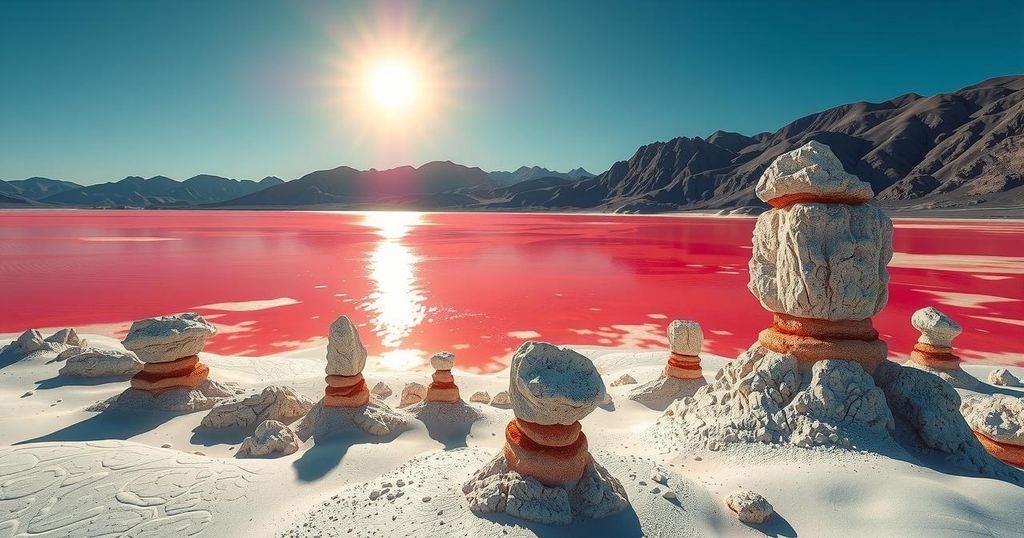Lake Natron: The Bizarre Red Lake in Tanzania That Turns Animals to Stone
Lake Natron in Tanzania is a stunning yet dangerous natural wonder that transforms deceased animals into calcified statues due to its extremely caustic waters. The lake, colored by microorganisms, supports a thriving ecosystem, notably serving as the breeding ground for up to 2.5 million lesser flamingos. Conservation efforts are essential to maintain this unique environment while ensuring safe visits for tourists.
In northern Tanzania, a captivating yet deadly phenomenon exists: Lake Natron. This remarkable body of water, with its striking crimson hue, draws attention from visitors, while simultaneously posing lethal risks to nearby wildlife. It’s one of the most unique natural wonders in Africa, characterized by its extreme conditions that can turn unfortunate animals into calcified statues.
Lake Natron, a shallow basin of caustic water, gleams under the harsh African sun. Its vivid red color results from specialized microorganisms that thrive in its highly alkaline environment. The lake’s chemistry is astounding, with pH levels soaring to 10.5, almost as caustic as household ammonia. These severe conditions create a hostile habitat where most animals suffer severe burns just by approaching its shores.
During dry seasons, the lake’s water recedes substantially, intensifying its chemical makeup. Temperatures can spike to 140°F (60°C), making it resemble a scorching cauldron. Despite its vast expanse of nearly nine miles wide, Lake Natron is very shallow – typically only about 1.6 feet deep – leading to rapid evaporation and marked seasonal changes.
One of the most intriguing aspects of Lake Natron is its ability to preserve deceased wildlife, leaving them to appear as if they have turned to stone. Animals that perish near the water undergo a mummifying process due to the lake’s high sodium carbonate concentration. This effectively replaces organic tissue with mineral deposits.
Notably, wildlife photographer Nick Brandt spotlighted this eerie transformation in his work “Across the Ravaged Land” in 2013. His powerful photographs feature perfectly preserved birds and bats, eternally posed as if still alive yet tragically calcified. These pictures spotlight local wildlife such as doves and fish eagles transformed into ghostly monuments by the lake’s unique chemistry.
This petrification occurs rapidly. After dying, animals take in the mineral-rich waters, and as the water evaporates, their bodies slowly convert into stone-like figures. This natural process mirrors modern scientific techniques used for specimen preservation, showcasing nature’s efficiency in maintaining its biological history.
Oddly enough, despite the lake’s deadly qualities, it also supports a thriving ecosystem. Most notably, Lake Natron serves as the primary breeding ground for lesser flamingos (Phoeniconaias minor). These fascinating birds have adapted specifically for life in such caustic waters. Their tough scales protect their legs from chemical burns, while their specialized beaks efficiently extract nutrients from the waters.
A staggering 1.5 to 2.5 million lesser flamingos depend on this habitat to reproduce, which accounts for about 75% of their global population. During drier conditions, small islands form that serve as safe nesting areas from predators, thanks to the caustic waters that deter hunters.
The unique microorganisms responsible for Lake Natron’s color also serve as sustenance for the flamingos, which absorb pigments through the algae they consume. This striking food chain illustrates how extreme environments can nurture specialized life forms.
Researchers often study Lake Natron and its unique habitat as a model for understanding how life might emerge in similar harsh conditions on other planets, like Mars. The adaptations seen in the organisms that inhabit this extreme region provide researchers important insights into biological resilience and survival.
Visiting Lake Natron is not without its challenges; it requires thorough planning and respect for the dangers it presents. Tourist safety is paramount, so local guides help navigate safe viewing areas for those eager to experience the crimson waters and the flamingo colonies without risk.
The landscape surrounding the lake offers a contrast to its stark waterways. Rich salt marshes and freshwater wetlands sustain a diverse range of wildlife, including greater flamingos, pelicans, and wildebeests. These adjacent ecosystems provide visitors safe opportunities to appreciate the region’s remarkable natural beauty.
Conservation efforts aim to maintain the lake’s ecological balance. The Tanzania Wildlife Management Authority enforces regulations to protect breeding flamingos and preserve the lake’s uniqueness. Such initiatives ensure that future generations can continue to celebrate this incredible natural wonder, illustrating the duality of life and death that characterizes Lake Natron.
Lake Natron, a mesmerizing yet lethal body of water in Tanzania, exemplifies nature’s extremes. While it preserves deceased wildlife as stone-like sculptures, the lake also nurtures specialized species, particularly lesser flamingos. Despite its harsh environment, it ultimately serves as a critical habitat for these fascinating birds, showcasing the complex interplay between life and death. Conservation efforts remain essential to protect this unique ecosystem for the future.
Original Source: thinkstewartville.com




Post Comment